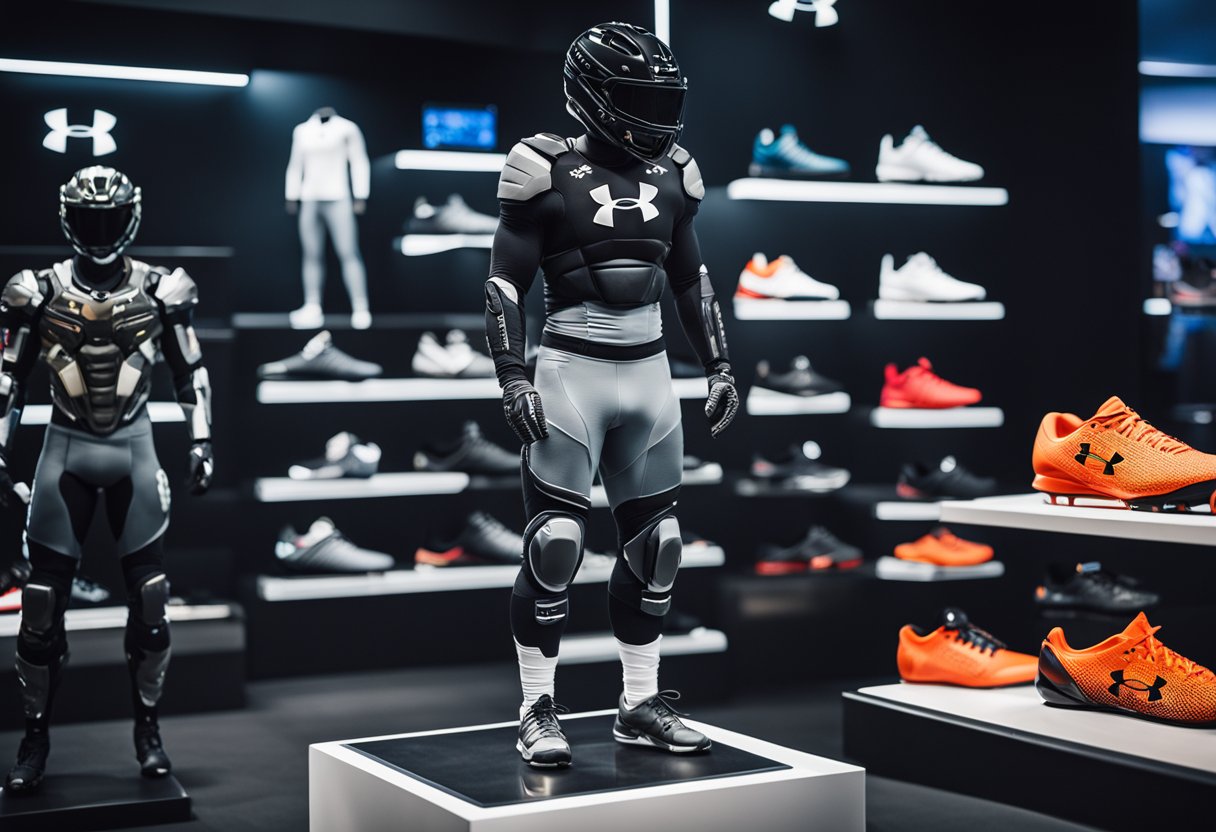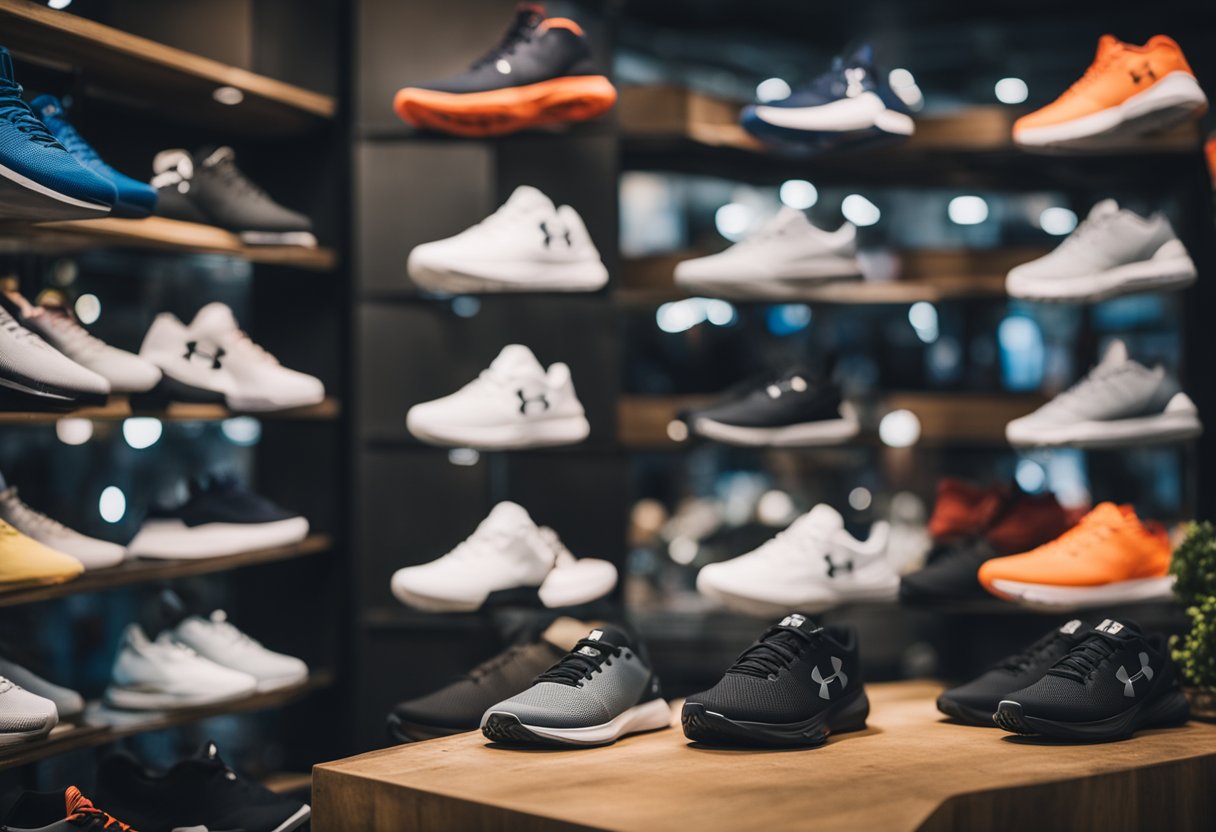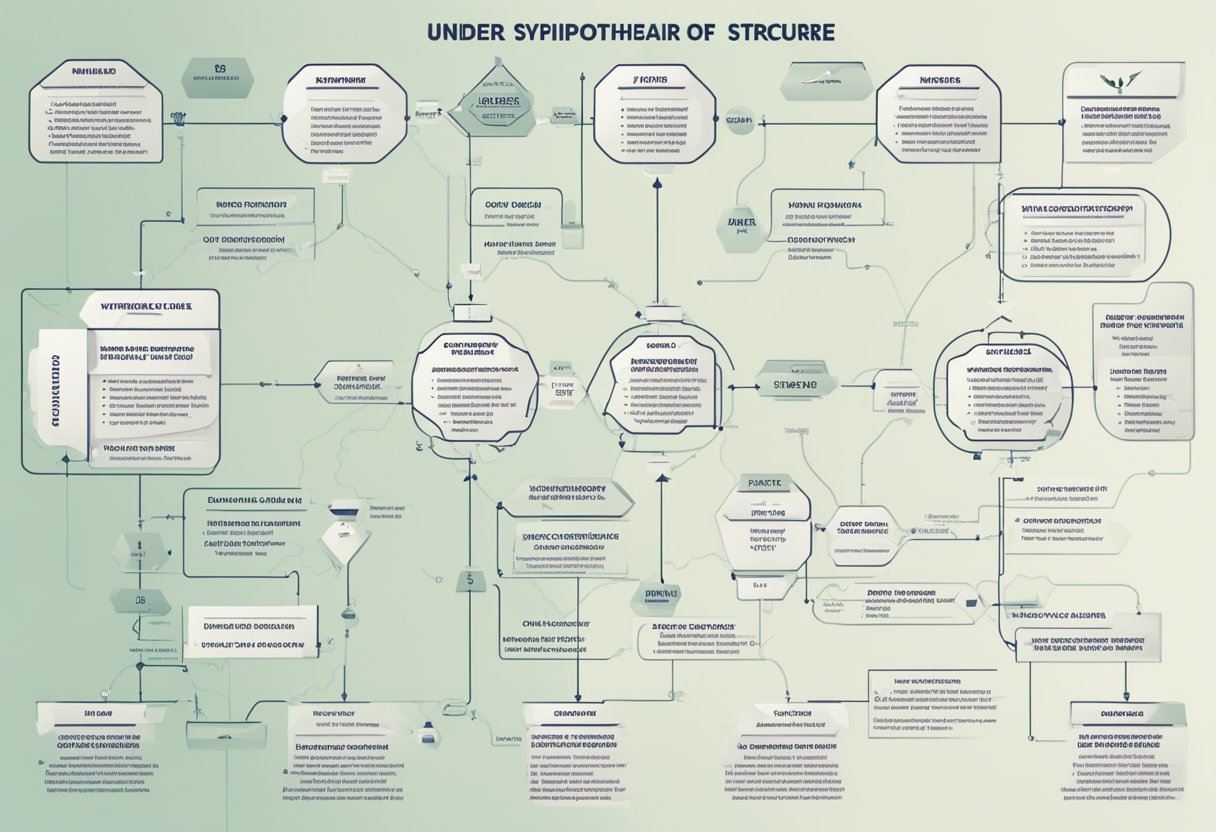Under Armour is a major American sportswear company that has made its mark in the athletic apparel industry. Founded in 1996, the company has grown from a small startup to a global brand competing with industry giants.
Kevin Plank is the founder and executive chairman of Under Armour. The company is now publicly traded with major shareholders including BlackRock Advisors LLC and Fidelity Management & Research Co. LLC, who each own approximately 15% of the company.

The journey of Under Armour began when Kevin Plank, a former University of Maryland football player, created a moisture-wicking shirt in his grandmother’s basement. From this humble beginning, he built the Baltimore-based sportswear company that manufactures footwear, apparel, and accessories.
The brand celebrated its 25th anniversary in 2021, marking a quarter-century of innovation in athletic wear.
Key Takeaways
- Kevin Plank founded Under Armour and serves as executive chairman, while the company is publicly traded with institutional investors owning significant shares.
- Under Armour has evolved from a single moisture-wicking shirt to a global sportswear brand that manufactures apparel, footwear, and accessories.
- The Baltimore-headquartered company celebrated 25 years in business in 2021 and continues to be a recognizable competitor in the athletic wear market.
Company Overview

Under Armour has grown from a small startup to a global sportswear giant under the leadership of its founder Kevin Plank. The company’s journey reflects its commitment to performance and innovation in athletic apparel.
Founding and Evolution
Under Armour was founded by Kevin Plank, a former University of Maryland football player who noticed athletes’ need for better moisture-wicking shirts. He started the company in 1996 from his grandmother’s basement in Washington D.C.
The brand quickly gained popularity when Plank convinced collegiate and NFL teams to try his innovative shirts. This grassroots approach helped the company build credibility among athletes.
Today, Under Armour has expanded beyond its initial compression shirts to offer footwear, casual wear, and accessories. The company is now sold in over 140 countries worldwide with hundreds of retail locations.
Under Armour went public in 2005, and while Plank remains the executive chairman, the ownership structure now includes major shareholders like BlackRock Advisors and Fidelity Management.
Brand Philosophy and Slogan
Under Armour’s core philosophy centers on performance innovation and helping athletes perform better. The brand focuses on creating technically advanced products that provide a competitive advantage.
Their famous “Protect This House” slogan emerged in 2003 as part of their first major marketing campaign. This battle cry resonated with athletes and helped establish the brand’s identity as fierce and competitive.
The company’s mission extends beyond just selling apparel. Under Armour aims to inspire athletes at all levels through:
- Continuous product innovation
- Authentic connections to sports culture
- Performance-driven design principles
This philosophy has helped Under Armour compete with established sportswear giants while maintaining its unique identity as a brand built by athletes for athletes.
Leadership

Under Armour’s leadership structure includes key executives who guide the company’s strategy and a board of directors who provide oversight. The company has experienced several leadership transitions in recent years.
Executive Leadership
Kevin Plank, Under Armour’s founder, has returned as President and Chief Executive Officer effective April 1, 2024. This marked a significant leadership change for the athletic apparel company.
Plank founded Under Armour in 1996 and previously stepped down as CEO, but maintained influence as the company’s controlling shareholder. His return aims to reinvigorate the brand amid recent struggles.
The executive team includes Douglas E. Coltharp, who serves as Executive Vice President and Chief Financial Officer. Together with Plank, these executives are responsible for day-to-day operations and implementing the company’s strategic vision.
Board of Directors
The Board of Directors provides governance and oversight for Under Armour. Kevin Plank holds the position of Executive Chair of the board, giving him significant influence over the company’s direction.
The board consists of experienced professionals who bring diverse expertise in retail, finance, and corporate governance. They work to ensure the company maintains responsible business practices and creates value for shareholders.
Under Armour’s executive team ratings indicate some challenges, receiving a “C-” grade according to employee feedback. This suggests potential areas for improvement in leadership effectiveness and employee satisfaction.
Board members collaborate with executive leadership to establish long-term strategies and guide Under Armour through competitive markets and changing consumer preferences.
Products and Innovations

Under Armour has built its reputation on cutting-edge products that enhance athletic performance. The company continuously develops new materials and technologies to give athletes an edge in their activities.
Footwear and Gear
Under Armour offers a wide range of footwear for various sports and activities. Their shoe lineup includes running shoes, training footwear, basketball sneakers, and cleats for sports like football and baseball.
The company expanded from its original compression shirt business to create comprehensive sportswear collections that cover all athletic needs. Their product line now features:
- Performance apparel for all seasons
- Sports bras and athletic underwear
- Accessories like bags, gloves, and headwear
- Equipment for team sports and training
Under Armour operates brand and factory houses globally, making their products accessible to athletes worldwide. These retail locations showcase their latest gear and provide customers with direct access to their innovations.
Technology and Design
The UA Flow technology represents one of Under Armour’s most significant innovations. This technology was recognized in the 2022 Edison Awards for its excellence in performance-based design.
UA HOVR™ is another breakthrough technology that provides responsive cushioning in their footwear. This system creates a “zero gravity feel” that helps reduce impact while returning energy to the wearer during movement.
The company’s design philosophy emphasizes both functionality and style. Kevin Plank, the founder, ensures that innovation plays a key role in how Under Armour products look and perform.
Their technological advances include:
- Moisture-wicking fabrics that keep athletes dry
- HeatGear® for hot weather performance
- ColdGear® for winter activities
- Compression materials that support muscles during activity
Marketing Strategy

Under Armour’s rise to prominence in the sportswear industry stems from its bold marketing approaches and strategic partnerships. The company has consistently invested in innovative campaigns that highlight product performance while securing key sponsorships to build brand credibility.
Advertising Campaigns
Under Armour has developed innovative product launches and ground-breaking campaigns that helped them compete with established sportswear giants. Instead of focusing on discounts, the company has shifted to emphasizing its products and brand value in its advertising messages.
Their memorable “Protect This House” campaign created a battle cry that resonated with athletes and casual wearers alike. The “I Will” campaign further strengthened their position as a brand for determined performers.
Recently, Under Armour has announced plans for its most significant marketing push as part of CEO Kevin Plank’s turnaround strategy. This new direction aims to win back shoppers and revitalize the brand’s appeal.
Sponsorships and Partnerships
Under Armour has strategically formed partnerships with high-profile athletes and sports teams to boost brand visibility. Their relationship with basketball star Stephen Curry created one of their most successful signature shoe lines.
The company has secured deals with major collegiate athletic programs, providing uniforms and equipment while gaining valuable exposure to younger demographics. These partnerships have helped Under Armour build credibility in competitive sports markets.
Under Armour also collaborates with fitness technology companies, expanding their ecosystem beyond apparel. Their connected fitness platforms show how the brand extends its reach through digital partnerships.
By following Kevin Plank’s go-to-market lessons, Under Armour continues to use partnerships to strengthen their position against established competitors.
Market Presence

Under Armour has built a strong position in the competitive sportswear industry through strategic targeting and global expansion efforts. The company now sells its products in over 140 countries and operates more than 445 brand and factory stores worldwide.
Target Demographics
Under Armour primarily focuses on athletes and fitness enthusiasts who value high-performance gear. The Baltimore-based sportswear company appeals strongly to young athletes and those who identify with an active lifestyle.
Their marketing often features professional athletes and emphasizes the technical aspects of their products. This approach helps them connect with customers who take their athletic pursuits seriously.
The brand has successfully positioned itself as an alternative to traditional sportswear giants. Under Armour’s bold designs and performance-focused messaging attract consumers who want to stand out in the sports landscape.
Many young athletes see Under Armour as representing a movement toward innovative sports technology rather than just fashion.
Global Expansion
Under Armour has grown significantly from its American roots to become an international brand. Their products are now sold in more than 140 countries across the globe, showing their widespread appeal.
The company operates over 445 Under Armour owned and operated brand and factory house stores globally. These physical locations help strengthen the brand’s presence in key markets.
Their expansion strategy focuses on bringing their performance-oriented products to athletes worldwide. This global approach has helped them compete with other major sportswear brands.
In emerging markets, Under Armour positions itself as a premium American brand. This has allowed them to capture market share in regions where consumers aspire to own high-quality athletic gear.
Corporate Information

Under Armour operates as a public company headquartered in Baltimore, Maryland. Founded by Kevin Plank, the company has established structures for investor relations and maintains a diverse shareholder base.
Investor Relations
Under Armour provides comprehensive resources for those interested in the company’s financial performance. They offer news, stock information, and financial reports through their dedicated investor relations channels.
The company has created corporate governance guidelines that establish how they operate and conduct business. These guidelines help provide transparency for investors and analysts who monitor the company’s performance.
Investors can access:
- Quarterly earnings reports
- Annual financial statements
- Corporate governance documents
- Shareholder resources
The company regularly hosts earnings calls. During these calls, executives discuss performance metrics and answer questions from financial analysts.
Shareholders and Stock
Under Armour’s ownership structure includes major institutional investors who hold significant positions in the company. According to market data, Vanguard Fiduciary Trust Co. owns approximately 16.86% of the company with 31,843,022 shares.
BlackRock Advisors LLC holds about 15.18% of Under Armour with 28,656,369 shares. Fidelity Management & Research is also among the top shareholders.
The company offers multiple classes of stock:
- Class A (voting rights)
- Class C (non-voting)
This structure allows founder Kevin Plank to maintain significant control over the company while still being publicly traded. The stock trades on major exchanges, giving retail investors the opportunity to own parts of this popular sportswear brand.
Customer and Supplier Engagement

Under Armour maintains strong connections with both customers and suppliers to drive brand loyalty and ensure quality products. These relationships form the backbone of the company’s operational success and market position.
Customer Service
Under Armour values direct communication with its customers through multiple channels. The company recently launched its first loyalty and rewards program, a significant step toward consumer-direct engagement. This program helps build stronger relationships with repeat customers while gathering valuable insights about purchasing patterns.
When customers have concerns or feedback, they can easily reach out to the company. Under Armour’s corporate governance page notes that communications from customers are distributed to the board, showing the company’s commitment to listening at the highest levels.
The brand’s customer service team handles product questions, warranty issues, and return policies with a focus on satisfaction. Their responsive approach aims to build trust and encourage long-term loyalty.
Supplier Partnerships
Under Armour recognizes that suppliers play a crucial role in their success. The company values the diverse backgrounds and perspectives that suppliers’ workers bring, considering them central to driving long-term success.
During challenging times, Under Armour has shown innovation in supplier management. In February 2020, the company established “Project Buffalo,” a specialized team focused on supply chain challenges. This demonstrated their adaptability during global disruptions.
The company maintains ethical standards for suppliers through a comprehensive code of conduct. Regular factory audits and transparency initiatives ensure compliance with labor and environmental practices throughout their global supply network.
Current Ownership Structure

Under Armour has a mix of individual and institutional shareholders. The company was founded by Kevin Plank, who remains a major shareholder and influential figure in the company.
Large investment firms hold significant portions of Under Armour stock. For example, BlackRock Advisors LLC owns about 15.18% of the company shares, making them one of the top institutional investors.
Fidelity Management & Research Co. LLC has a similar stake at 15.01%, showing how investment giants have taken interest in the sportswear brand.
The Vanguard Group is another notable institutional investor in Under Armour. They manage retirement accounts and funds that include Under Armour stock.
Under Armour is publicly traded, allowing anyone to buy shares. However, these major players control substantial voting power within the company.
Executive leadership also maintains ownership stakes. This includes people like David Bergman and Douglas Coltharp, who are listed among top shareholders.
BDT Capital Partners rounds out the group of significant shareholders with substantial investment in the athletic apparel company.




